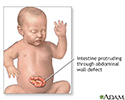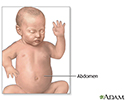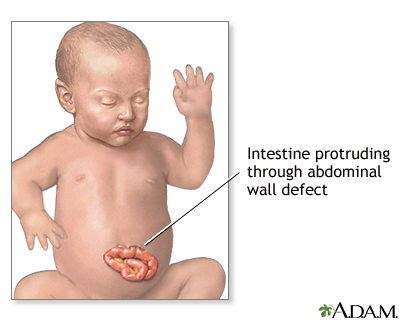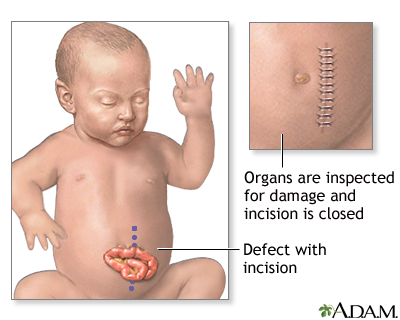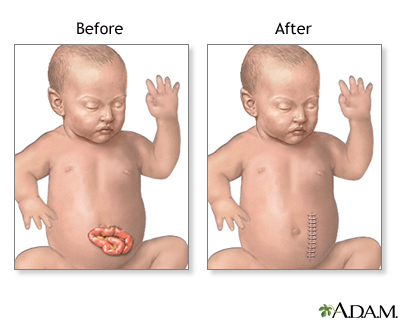Gastroschisis
Birth defect - gastroschisis; Abdominal wall defect - infant; Abdominal wall defect - neonate; Abdominal wall defect - newborn
Gastroschisis is a birth defect in which an infant's intestines are outside of the body because of a hole in the abdominal wall.
Causes
Babies with gastroschisis are born with a hole in the abdominal wall. The child's intestines often stick out (protrude) through the hole.
The condition looks similar to an omphalocele . An omphalocele, however, is a birth defect in which the infant's intestine or other abdominal organs protrude through a hole in the belly button area and are covered with a membrane. With gastroschisis, there is no covering membrane.
Omphalocele
An omphalocele is a birth defect in which an infant's intestine or other abdominal organs are outside of the body because of a hole in the belly butt...

Abdominal wall defects develop as a baby grows inside the mother's womb. During development, the intestine and other organs (liver, bladder, stomach, and ovary or testes) develop outside the body at first and then usually return inside. In babies with gastroschisis, the intestine (and sometimes the stomach) remains outside the abdominal wall, without a membrane covering them. The exact cause of abdominal wall defects is not known.
Babies with gastroschisis usually do not have other related birth defects.
Symptoms
A gastroschisis can be seen by the health care provider when the baby is born. There is a hole in the abdominal wall. The small intestine is often outside the abdomen near the umbilical cord. Other organs that may also be seen are the large intestine, stomach, or gallbladder.
If the intestine is damaged, the baby will have problems absorbing food.
Exams and Tests
Prenatal ultrasounds often identify infants with gastroschisis before birth. While pregnant, the mother may have shown signs of too much amniotic fluid ( polyhydramnios ). A prenatal ultrasound often identifies the gastroschisis.
Polyhydramnios
Polyhydramnios occurs when too much amniotic fluid builds up during pregnancy. It is also called amniotic fluid disorder, or hydramnios.

Treatment
If gastroschisis is found before birth, the mother will need special monitoring to make sure her unborn baby remains healthy.
Treatment for gastroschisis is surgery to repair the defect . The surgeon will put the bowel back into the abdomen and close the defect, if possible. If the abdominal cavity is too small, a mesh sack is stitched around the borders of the defect and the edges of the defect are pulled up. The sack is called a silo. With growth, the intestine returns into the abdominal cavity and the defect can be closed.
Surgery to repair the defect
Gastroschisis repair is surgery to correct a birth defect that causes an opening in the skin and muscles covering the belly (abdominal wall). The op...

Other treatments for the baby include nutrients by IV and antibiotics to prevent infection. The baby's temperature must be carefully controlled, because the exposed intestine allows a lot of body heat to escape.
Outlook (Prognosis)
The baby has a good chance of recovering if the abdominal cavity is large enough. A very small abdominal cavity may result in complications that require more surgeries.
Plans should be made for careful delivery and immediate management of the problem after birth. The baby should be delivered in a medical center that is skilled at repairing abdominal wall defects. The baby is likely to do better if they do not need to be taken to another center for further treatment.
Possible Complications
The misplaced abdominal contents can make it difficult for the baby to expand the lungs, leading to breathing problems.
Another complication is bowel death. This occurs when intestinal tissue dies due to low blood flow or infection.
This condition is apparent at birth and will be detected in the hospital at delivery if it has not already been seen on routine fetal ultrasound exams during pregnancy. If you have given birth at home and your baby appears to have this defect, call the local emergency number (such as 911) right away.
When to Contact a Medical Professional
This problem is diagnosed and repaired in the hospital at birth. After returning home, call your provider if your baby develops any of these symptoms:
- Decreased bowel movements
- Feeding problems
- Fever
- Green or yellowish green vomit
- Swollen belly area
- Vomiting (different than normal baby spit-up)
- Worrisome behavioral changes
References
Islam S. Congenital abdominal wall defects. In: Holcomb GW, Murphy JP, Ostlie DJ, eds. Ashcraft's Pediatric Surgery . 6th ed. Philadelphia, PA: Elsevier Saunders; 2014:chap 48.
Walther AE, Nathan JD. Newborn abdominal wall defects. In: Wylie R, Hyams JS, Kay M, eds. Pediatric Gastrointestinal and Liver Disease . 5th ed. Philadelphia, PA: Elsevier; 2016:chap 58.
-
Infant abdominal hernia (gastroschisis) - illustration
An abdominal hernia (gastroschisis) occurs when there is an area where the muscles are weak, and this allows the internal organs to bulge through the abdominal wall.
Infant abdominal hernia (gastroschisis)
illustration
-
Gastroschisis repair - series
Presentation
-
Infant abdominal hernia (gastroschisis) - illustration
An abdominal hernia (gastroschisis) occurs when there is an area where the muscles are weak, and this allows the internal organs to bulge through the abdominal wall.
Infant abdominal hernia (gastroschisis)
illustration
-
Gastroschisis repair - series
Presentation
Review Date: 11/3/2015
Reviewed By: Kimberly G Lee, MD, MSc, IBCLC, Associate Professor of Pediatrics, Division of Neonatology, Medical University of South Carolina, Charleston, SC. Review provided by VeriMed Healthcare Network. Also reviewed by David Zieve, MD, MHA, Isla Ogilvie, PhD, and the A.D.A.M. Editorial team.

